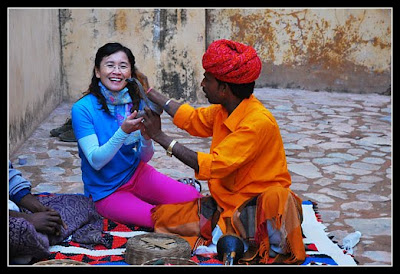Our first stop for today is at Hawa Mahal, just to take the picture from the front building.
Hawa Mahal is a major landmark and a famous tourist attraction of Jaipur. The Palace offers a beautiful sight to behold. The splendid Rajputana architecture of Hawa Mahal, still speaks the glory of the royal family. However, one can also find a glimpse of Mughal architecture, which is blended perfectly to make it different from others. The literal meaning of Hawa Mahal is Palace of Winds. Hawa Mahal was built by Maharaja Sawai Pratap Singh in 1799.
Hawa Mahal is a pyramid-shaped facade with five stories. It has 953 small windows decorated with tiny lattice work. These pink sandstone windows commonly known as "Jharokhas" are constructed in such a style, that it looks like a giant honeycomb.
As a matter of fact, Hawa Mahal is believed to build for the women of the Royal Families, since they had to observe strict "purdah" (cover). The small windows and screened balconies serve the women to watch processions and different activities taking place on the streets. In this manner, the women could enjoy a sense of freedom without showing themselves.Amber Fort is located in Amber (Jaipur), which used to be the capital of the Kachhwaha clan, till Jaipur was made the official capital in 1727. The Amber Fort looks stunning, all-built in white marble and red sandstone. To add to its charm, Maotha Lake makes its foreground. The crystal mirror image of the Fort, on the still waters of the lake, seems to be a beautiful illusion. Amber Fort is usually pronounced as Amer Fort. In 1592, construction of the Fort was started by Raja Man Singh I. However, the Amber Fort took its present form during the reign of Raja Jai Singh I. The marvelous decoration of the Amer Fort is influenced by both, the Hindu and Muslim manner of ornamentation.






 Amber Fort as viewed from its front across Maotha lake.
Amber Fort as viewed from its front across Maotha lake. Tourists can ride up to the fort from the base of the hill on elephants.
Tourists can ride up to the fort from the base of the hill on elephants.We then come back to the town to visit City Palace Jaipur .
The beautiful palace was built by Maharaja Sawai Jai Singh during his reign. Among the various forts and palaces of Jaipur, City Palace stands apart, with its outstanding art and architecture. City Palace complex covers a huge area, which is divided into a series of gardens, courtyards and buildings. Initially, Raja Jai Singh built the outer wall occupying a huge area. The additional grand buildings were constructed later by the succeeding rulers.
A part of the exquisite Palace still makes home for the former Maharaja/ King. The premises consists several buildings like Chandra Mahal, Mubarak Mahal, Mukut Mahal, Maharani's Palace, Shri Govind Dev Temple and the City Palace Museum.







 The palace architects achieved a fusion of the Shilpa shastra of Indian architecture with Rajput, Mughal and European styles of architecture.
The palace architects achieved a fusion of the Shilpa shastra of Indian architecture with Rajput, Mughal and European styles of architecture.Those two places take us some hours, so by the time that we finish the city palace tour, we are so hungry that we have to find something to eat before we proceed to Jantar Mantar.
 Jantar Mantar
Jantar Mantar The Jantar Mantar is a collection of architectural astronomical instruments, built by Maharaja (King) Jai singh II at his then new capital of Jaipur between 1727 and 1734. It is modeled after the one that he had built for him at the Mughal capital of Delhi. He had constructed a total of five such facilities at different locations, including the ones at Delhi and Jaipur. The Jaipur observatory is the largest and best preserved of these.
Then we come back to our bus and ask our driver to the last one, Galtaji Temple.
 Galtaji Temple
Galtaji TempleThanks Mer for the info: Galtaji is a holy pilgrimage of India, located 10 kms away from Jaipur in Rajasthan. The vast complex of Galta Ji has several temples in it. The Temple of Galtaji is famous for its natural water springs.




No comments:
Post a Comment